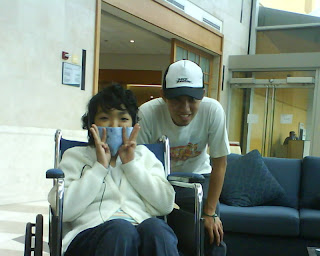
Today is Yam's 1st Bone Marrow Transplant Anniversary. Yeah, happy anniversary and long, happy, fulfilling life to Yam!!!
(Yam is at front extreme right with Grade 6 classmates at Philippine Women's College of Davao City, photo taken August 2007)
Story of my daughter, Yam, who courageously fought and conquered leukemia, with much help from countless friends and good samaritans. She relapsed after almost two years and quickly lost the battle. But the war continues. Her memory survives. And her survivors live on to tell her story)

Two days ago, she was discharged from a five-day hospitalization at the
Setbacks are not uncommon to patients like her. After transplant, she bounced back fast. She engrafted two days earlier than usual, was discharged a week earlier than most, and was cleared to travel back to Davao three weeks earlier than the 100 day mark. It was generally smooth sailing from here with few setbacks. These included the need to administer valganciclovir to control cytomegalovirus two days after her initial discharge last October, an involuntary muscle contraction due to ion imbalance last February, hives in July, a bacterial infection in August, and this period.
Looking forward to the first year anniversary, was it really worth all the risk? We considered two views. First, that of medical science:
"The hope with a transplant is to cure the underlying disease," says Christopher Bredeson, M.D., M.S., assistant professor of medicine at the
"It's a balancing act," Dr. Bredeson says. "In a young patient, a transplant may be worth the risk for long life. In an older patient who says 'I just want to see my grandson get married in the fall,' it may not be."
Our view when we were in the maelstrom of decision-making was perhaps typical of parents. We just wanted to do everything and anything for our daughter. We didn’t leave things to chance, we didn’t relish the thoughts of, “what if…”, “why didn’t we…”. We confronted the situation like it was war, and we were determined to win. Or if we were to lose, then we lose with our boots on.
Now, more than a year after deciding on the transplant, we feel secured of our decision. The setbacks, preventive measures, periodic check up and treatment our daughter needed to go through after the transplant are but integral consequences of that decision.
Today, we are looking forward to relish our daughter’s long, meaningful life, and to better appreciate the "why" of all these things. These, to us and the countless good Samaritans who helped us, is the heart of the matter.
 18 September 2007. Are these what we really feel? Or what we are trying to feel? I guess it’s more of the former than the latter.
18 September 2007. Are these what we really feel? Or what we are trying to feel? I guess it’s more of the former than the latter.
Since being back to school in June after a bone marrow transplant in September last year, we had been very careful and protective of her. Last month after a rather active week, she was to join an essay writing contest. On our way, she suddenly wept saying we can't proceed. She wasn't feeling well. On the days ahead, she was at home nursing bacterial infection.
Two weeks ago, she spent a night with her closest friend. Then the week that followed was an exam week. On Saturday of that week, she joined the regional science quiz where her team placed third overall. The quiz was in nearby Panabo City. On our travel back home, she just lied down at the back of the van, seemingly energy-sapped from the long day's activities. She immediately slept after reaching home. The following day, she was nursing a fever. When we brought her to her pediatrician on the succeeding Monday, we were immediately advised that she be admitted.
Her lab analysis shows that her blood counts were low. Her blood culture yielded no distinct bacterial growth. But in a couple of days, she developed mouth sores. It was the candida fungus. She was then subjected to viral tests but no conclusive resuls as yet.
Mean time, she remains in the hospital. Suspicion of a possible cytomagalovirus is at hand, but the test must be done in Manila since it must be done within an hour of blood extraction. Yam's condition improved a bit, her mouth sores more manageable. But her blood counts remained low.
Anxious. That's the normal feeling for a not so normal situation.+032.jpg)